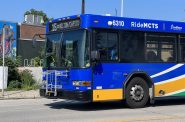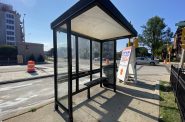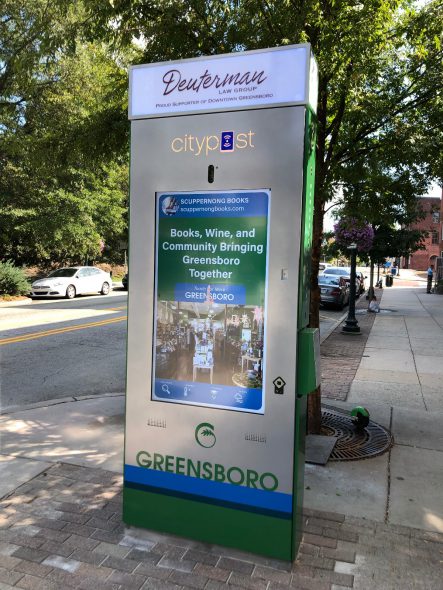Streetcar Kiosks Could Bring In $500,000 Annually
System of 35 interactive kiosks could be online as early as May.
Milwaukee’s streetcar system will soon be more visible, as will a lot of advertisements.
A public-private partnership between the City and Smart City Media will enable the construction of 35 eight-and-a-half-feet-tall “smart kiosks” at the 17 streetcar stops on the 2.1-mile-long first phase and additional nearby locations.
Smart City Media is a privately-owned company that partners with transit systems and other entities to install and operate interactive, digital kiosks providing information and advertisements.
The city anticipates hundreds of thousands of dollars annually from the privately-owned system. “We’re being a little bit conservative, but it’s probably in that $300,000 to $500,000 range,” said Department of Public Works Commissioner Jeff Polenske on Thursday morning before the Public Works Committee. “It could be more.”
Beyond providing streetcar operations funding as part of a revenue-sharing agreement, Polenske said the system will provide valuable information on upcoming vehicle arrivals, including a countdown timer, and other wayfinding information. Directions to nearby bus routes and Bublr Bikes stations will be available. “We always intended to fulfill those gaps in communications,” said Polenske.
The 41-inch-wide and 11.6-inch-deep kiosks, known as CityPosts, include a 55-inch touchscreen. Users will see ads approximately half the time and touch the screen to access information. Smart City will sell those ads.
“A lot of what they’re doing is selling their entire network,” said Mark Rosenberg of 2-Story, the streetcar’s marketing and communication consultant. Smart City also operates kiosks near transit systems in Kansas City, Little Rock, Louisville, Memphis and is currently deploying 300 kiosks in Dallas.
Additional kiosks will be installed at locations intended to help increase the visibility of The Hop and vice versa. “For example, the stops on [E. Ogden St.], trying to make that connection to Brady Street,” said Polenske, noting only four blocks separate the streetcar from the Lower East Side commercial corridor. All of the locations will be located in the public right of way. “Right now we are working on the locations.”
Alderman Robert Bauman asked about public safety benefits. The locations will include 360-degree cameras accessible by the Milwaukee Police Department said Rosenberg. They will also have cameras and microphones for users to interact with in the event of emergencies.
The kiosks would have the capability to make noise on their own through the ads, even without interaction, but Polenske said the contract prevents that from happening without city approval. “Short of that, especially not on a regular basis, we should not be making noise on a public street,” said Ald. Nik Kovac.
The first kiosks could be installed as early as May, with the full system online by July in time for the Democratic National Convention.
The city, as part of a 10-year agreement, will receive 20 percent of the advertising revenue over the first three years and up to 33 percent of the revenue over the remainder of the deal. It would not have to pay to install and maintain the kiosks.
The city’s 2020 budget includes $4.65 million for streetcar operations, including the lakefront line extension, with funding coming from a federal operating grant ($3.5 million), Potawatomi ($781,000) and advertising ($368,000).
A three-mile expansion plan remains on hold by the Milwaukee Common Council. A previously approved expansion to the lakefront, scheduled to open in 2020, faces uncertainty now that The Couture apartment tower, through which it was supposed to run, has not broken ground.
If you think stories like this are important, become a member of Urban Milwaukee and help support real, independent journalism. Plus you get some cool added benefits.
More about the Milwaukee Streetcar
For more project details, including the project timeline, financing, route and possible extensions, see our extensive past coverage.
- Alderman, State Allies Seek Federal Help to Kill the Streetcar - Jeramey Jannene - Oct 28th, 2025
- Streetcar Service Suspended Following Truck Crash - Jeramey Jannene - Oct 21st, 2025
- One Alderman’s Quest To Defund The Streetcar - Jeramey Jannene - Oct 18th, 2025
- Another Streetcar Collision - Jeramey Jannene - Jun 27th, 2025
- Streetcar Hit By Apparent Red Light Runner - Jeramey Jannene - Jun 16th, 2025
- Streetcar Will Run On Consolidated Route During Summerfest - Jeramey Jannene - Jun 11th, 2025
- City Hall: Milwaukee Must Replace Failing Streetcar Switches - Jeramey Jannene - Feb 24th, 2025
- Streetcar Confronts Limited Funding, Operations Challenges - Evan Casey - Jan 22nd, 2025
- Council Kills Streetcar’s ‘Festivals Line’ - Jeramey Jannene - Jul 31st, 2024
- Streetcar Will Use Festivals-Oriented Route Through Summer - Jeramey Jannene - Jul 9th, 2024
Read more about Milwaukee Streetcar here
Political Contributions Tracker
Displaying political contributions between people mentioned in this story. Learn more.
- February 11, 2016 - Nik Kovac received $50 from Jeff Polenske
Transportation
-
MCTS Adds 28 New Buses
 Jul 13th, 2024 by Graham Kilmer
Jul 13th, 2024 by Graham Kilmer
-
MCTS Designing New Bus Shelters
 Jul 10th, 2024 by Graham Kilmer
Jul 10th, 2024 by Graham Kilmer
-
MCTS Updates RNC Bus Detours To Better Serve Downtown, Riders
 Jul 9th, 2024 by Jeramey Jannene
Jul 9th, 2024 by Jeramey Jannene























I worry that we are being lured into a technology subscription service for an impractical and lightly-used transportation system that benefits only a small part of our city. Meanwhile, many other real needs are being neglected for lack of funds. As for possible public safety benefits of these kiosks, we would be much better off by investing in education and social infrastructure.
Will vandalism be a problem? It seems that the incidence of vandalized bus shelters has diminished. Maybe the persons involved got tired of that routine, so let’s hope they aren’t attracted to the kiosks.
sbaldwin001,
These kiosks are free; they cost the City nothing (except the space they occupy on public streets).
So, installing them takes no money away from other things like “education and social infrastructure”, and they actually will bring in money.
TransitRider,
Thank you for clarifying this, although I am a little concerned about the notion that we are building our own surveillance state. Does Milwaukee have any rules about when active monitoring and passive monitoring can be performed and about how long data will be kept? Will anyone besides the police have access to this system? Will money for police video monitoring replace money for police on the street?
Robots are taking over.